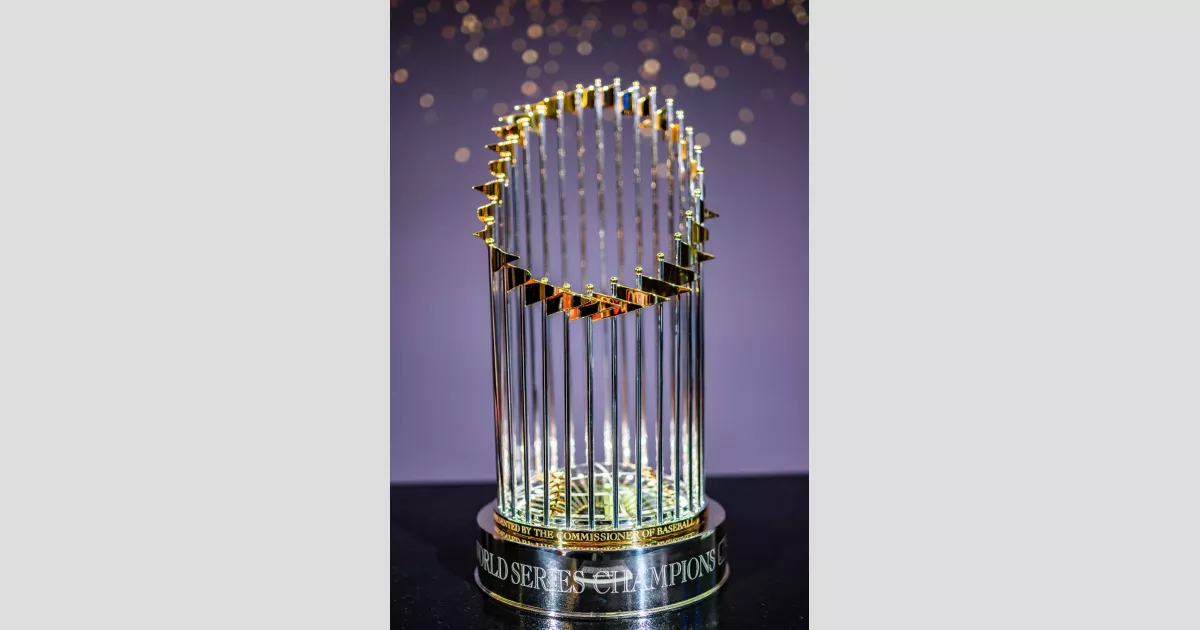1900: The Chronicle-Telegraph Cup Series
In 1900, the Chronicle-Telegraph Cup series was played, marking another attempt to create a postseason championship series following the regular season. It only occurred once and predated the modern World Series.
1903: Pittsburgh Pirates vs. Boston Americans: The Precursor to the Modern World Series
In 1903, a best-of-nine exhibition series between the Pittsburgh Pirates (NL) and Boston Americans (AL) took place, which is now recognized as the 1903 World Series. This series, arranged by the teams themselves, set the stage for the officially recognized World Series in subsequent years.
1903: First Instance of Best-of-Nine Format
The 1903 World Series was the first to adopt a best-of-nine format, a format that would be revisited in later years.
1903: First Modern World Series
The first modern World Series took place in 1903 and involved eight teams from each league, a total of 16 franchises. Remarkably, all these franchises are still active today and boast at least two World Series titles each.
1904: Brush Proposes "Brush Rules"
Following the cancellation of the 1904 World Series and facing criticism, John T. Brush, the owner of the New York Giants, proposed the "Brush Rules" during the winter of 1904-1905. These rules aimed to establish a framework for future World Series, including revenue sharing, game locations, and management.
1904: Boycott of the World Series
In 1904, the World Series was boycotted, marking a disruption in the annual event.
1904: Cancellation of the 1904 World Series
The 1904 World Series, which would have featured the Boston Americans (AL) and the New York Giants (NL), was canceled due to the Giants' owner, John T. Brush, refusing to participate. Brush cited the "inferiority" of the American League and declared his team "world champions" as champions of the "only real major league." This event highlighted the power struggle between the leagues and lack of a governing body for the World Series at the time.
1904: New York Giants Refuse to Play the New York Highlanders
The New York Giants management was not eager to play a potential World Series against their cross-town rivals, the New York Highlanders (later the New York Yankees), who were leading the AL at the time of the announcement. The Giants' refusal to participate in the 1904 World Series against any AL team, combined with their reasons, underscored the existing tensions and rivalries within the league.
1905: New York Giants Win First Official World Series under Brush Rules
In 1905, under the newly implemented "Brush Rules," John McGraw's New York Giants triumphed over the Philadelphia Athletics, marking the first officially recognized World Series victory under the new regulations.
1905: Implementation of "Brush Rules"
The "Brush Rules," established after the controversies of the previous year, were put into effect in 1905, bringing a level of structure and organization to the World Series, including the crucial element of the National Commission overseeing the event.
1917: White Sox World Series Victory
The Chicago White Sox won the World Series in 1917, two years before the infamous Black Sox Scandal.
1918: World Series Held Entirely in September
Due to World War I causing an early end to the regular season, the entirety of the 1918 World Series was held in September, a unique occurrence in World Series history.
1918: Red Sox Suffer Heartbreaking Loss in Game 6
Game 6 of the 1918 World Series saw a dramatic turn of events, solidifying the infamous "Curse of the Bambino." The Boston Red Sox, leading the series 3-2, were agonizingly close to victory, twice coming within one strike of the championship. However, the New York Mets staged an improbable comeback in the bottom of the 10th inning, capitalizing on a Bob Stanley wild pitch and a Bill Buckner error to tie the game and ultimately win the series in Game 7.
1918: Red Sox Last World Series Win at Fenway Before 2013
The 2013 World Series win marked a significant moment for the Boston Red Sox as it was their first World Series win at home since 1918.
1919: Black Sox Scandal
In 1919, eight players from the Chicago White Sox were accused of conspiring to intentionally lose the World Series, a major scandal that rocked the baseball world.
1919: Shifting Tides in Baseball
The 1919 World Series, coinciding with the beginning of the "live ball" era, marked a turning point in the fortunes of several baseball teams.
1919: Babe Ruth Joins the Yankees
The New York Yankees acquired Babe Ruth from the Boston Red Sox after the 1919 season, marking the beginning of their rise as a baseball powerhouse.
1919: Return to Best-of-Nine Format
The World Series reverted to a best-of-nine format, previously used in 1903, from 1919 to 1921.
September 1920: Black Sox Players Suspended
After nearly a year of circulating rumors, the players involved in the Black Sox Scandal were suspended from baseball in September 1920, despite being acquitted in a criminal conspiracy trial.
1920: Rise of the Yankees and Cardinals
The New York Yankees and St. Louis Cardinals, two of the most successful teams in baseball history, both won their first championships after 1920.
1920: Start of the Yankees Dynasty
The period from 1920 to 1964 marked the beginning of the New York Yankees dynasty, during which they won 20 World Series championships.
1921: End of Best-of-Nine Format
The 1921 World Series marked the end of the best-of-nine format until it was briefly revived in later years.
1921: Yankees' First World Series and First Radio Broadcast
The New York Yankees appeared in their first World Series in 1921, which also marked the first time the event was broadcast on the radio.
1924: Washington Senators Win Longest Seven-Game Series
The 1924 World Series, won by the Washington Senators (who later became the Minnesota Twins), holds the record for the longest seven-game World Series alongside the 1991 series.
1924: First Use of the 2-3-2 Home Game Pattern
The 2-3-2 home game pattern, which later became the standard format for the World Series, was first implemented in the 1924 World Series.
1924: Nationals Bring Title to the Capital
The Washington Nationals' victory in the 2019 World Series was especially significant for the city as it marked the return of the title to the nation's capital for the first time since 1924.
1925: Adoption of the 2-3-2 Home Game Pattern
In 1925, thanks to the efforts of Brooklyn owner Charles Ebbets, the World Series permanently adopted the 2-3-2 home game pattern. This format, first used in 1924, dictates the home-field advantage throughout the series.
1927: New York Yankees Achieve Wire-to-Wire Victory
The 1927 New York Yankees were one of the first teams in Major League history to lead a season wire-to-wire.
1928: End of Period Included in 1929 World Almanac
The 1929 World Almanac included baseball championships up to 1928, highlighting a period when perspectives on the World Series's historical scope were broader.
1929: World Almanac Recognition of Early Championships
The 1929 World Almanac and Book of Facts acknowledged baseball championships from 1884 to 1928 in a single table, reflecting an inclusive perspective on early baseball history.
1930: Distinction of 19th-Century Baseball
After 1930, many baseball authorities began to view 19th-century baseball as a precursor to the modern era, often listing the 1903 World Series as the official start and discussing earlier contests separately.
1935: Night Games Begin in MLB
Night games were introduced to Major League Baseball with the Cincinnati Reds in 1935.
1936: Start of Yankees' Four-Peat
The New York Yankees began a streak of four consecutive World Series wins in 1936.
1939: End of Yankees' Four-Peat
The New York Yankees' run of four straight World Series championships concluded in 1939.
1942: End of Period Included in 1943 World Almanac
The 1943 World Almanac's inclusion of championships up to 1942 further cemented the division between the modern World Series era and the 19th-century games.
1943: Shift in World Almanac Recognition
By 1943, the World Almanac listed "Baseball World's Championships" from 1903 to 1942, reflecting a shift in how the World Series's history was presented and solidifying the 1903 start date as standard.
1943: World War II's Impact on the World Series Format
Due to travel restrictions imposed by World War II, the 1943 and 1945 World Series followed a 3-4 home game pattern, a deviation from the established 2-3-2 format.
1944: Return to 2-3-2 Format Despite Wartime
Despite ongoing World War II travel restrictions, the 1944 World Series reverted to the standard 2-3-2 home game pattern as both participating teams shared the same home ballpark.
1945: End of the Wartime 3-4 Format
The 1945 World Series was the last to use the 3-4 home game format, a temporary measure adopted during World War II.
1945: Beginning of the Cubs' World Series Drought
The Chicago Cubs' long absence from the World Series began in 1945, marking the start of a period without a championship appearance until 2016.
1947: New York Dominates the World Series
From 1947 to 1964, with the exception of 1948 and 1959, at least one of New York City's three baseball teams (Yankees, Dodgers, and Giants) participated in every World Series.
1947: Gillette Sponsors World Series Telecasts
In 1947, Gillette began sponsoring the World Series telecasts, a relationship that would last until around 1965. Notably, the announcers for the Series during this period were selected by Gillette, alongside the Commissioner of Baseball and NBC. Interestingly, Gillette's sponsorship extended to purchasing airtime on multiple networks, including DuMont's affiliate WDTV (now KDKA-TV), ABC, CBS, and NBC, leading to the World Series being broadcast on three stations simultaneously in some cities.
1947: First Televised World Series
The World Series was first broadcast on television in 1947, but only to a limited audience in the northeastern United States via interconnected stations. Despite the limited reach, this event marked a turning point in how fans experienced the game.
1948: Open Access to World Series Telecasts
From 1948 to 1950, a period of open access to World Series telecasts was implemented, allowing any channel with a network affiliation to broadcast the games. This move democratized access to the World Series, contrasting with the later trend of exclusive broadcast rights.
1948: Limited World Series Broadcasts Continue
In 1948, the television broadcasts of the World Series remained limited, with games in different cities only accessible to viewers in their respective regions. This regional approach to broadcasting highlighted the technological constraints of the time.
1948: No New York Team in the World Series
The 1948 World Series did not feature a team from New York City, a rarity during that era.
1948: World Series Televised in Seven Midwestern Cities
The 1948 World Series saw an expansion of television coverage, with broadcasts reaching viewers in seven Midwestern cities. While still limited, this growth in viewership demonstrated the increasing interest in televised baseball.
1948: Cleveland's Last World Series Win
The Cleveland Indians last won the World Series in 1948, making their loss in the 2016 World Series particularly disheartening as it marked a continuation of their long championship drought.
1949: Yankees' Dominant Streak Begins
Between 1949 and 1964, the New York Yankees were a dominant force in baseball, reaching the World Series 14 times.
1949: World Series Broadcast Expands East of Mississippi River
By 1949, television broadcasts of the World Series extended their reach to encompass areas east of the Mississippi River. This expansion signified a significant step towards nationwide coverage of the event.
1949: Subway Series
The 1949 World Series was a "Subway Series," with both participating teams from New York City.
1949: Yankees' Five-Peat
The New York Yankees achieved an impressive feat by winning five consecutive World Series championships from 1949 to 1953.
1949: First World Series Game Finished Under Lights
The fifth and final game of the 1949 World Series marked the first time a game in the series concluded under artificial lighting due to fading daylight.
1950: End of Open Access Telecasts
1950 marked the end of an era where World Series telecasts were accessible to all channels with network affiliation. This period of open broadcasting, which began in 1948, allowed for broader access to the games but eventually gave way to more exclusive broadcast agreements.
1950: World Series Reaches Most of the Country
In 1950, the World Series reached a wider audience as television broadcasts became available to a larger portion of the country. This expansion reflected the growing accessibility of television and its impact on sports viewership.
1951: First Coast-to-Coast World Series Broadcast
1951 marked a pivotal moment for the World Series and television broadcasting, as it became the first year the event was broadcasted from coast to coast. This milestone demonstrated the ability to connect fans across the nation through the power of television.
1951: Subway Series
The 1951 World Series was another all-New York City affair.
1952: Subway Series
The 1952 World Series was once again contested between two New York City teams.
1953: Subway Series
The 1953 World Series was yet another "Subway Series."
1953: End of the Yankees' Five-Peat
The New York Yankees' streak of five consecutive World Series victories ended in 1953.
1954: Yankees Miss the World Series
The New York Yankees did not participate in the 1954 World Series, a rare occurrence during their dominant period.
1954: Athletics Move to Kansas City
The Philadelphia Athletics relocated to Kansas City during the 1954-1955 offseason.
1955: Yankees and Athletics Make Deals
Following the Athletics' move to Kansas City, the Yankees and Athletics struck several deals that benefited the Yankees until Charles O. Finley, the new Athletics owner, put an end to the arrangement.
1955: Brooklyn Dodgers Achieve Wire-to-Wire Victory
The 1955 Brooklyn Dodgers were one of the first teams in Major League history to lead a season wire-to-wire.
1955: Last September World Series Start
The 1955 World Series marked the last time the event began in late September due to the regular season's schedule not yet being expanded to 162 games.
1955: Subway Series
The 1955 World Series was another all-New York City matchup.
1955: First Color World Series Broadcast
The World Series took another leap forward in 1955 with the introduction of color television. This technological advancement enhanced the viewing experience for fans, bringing the vibrancy of the game into their homes.
1956: Subway Series
The 1956 World Series was one more "Subway Series," highlighting New York City's dominance in baseball during that period.
1956: Previous All-New York World Series
The 1956 World Series was the last time a World Series was played entirely in New York before the 2000 matchup between the Yankees and Mets.
1956: Last No-Hitter in World Series Before 2022
The 2022 World Series saw a historic moment in Game 4 when four Astros pitchers combined for a no-hitter. This incredible feat was the first no-hitter in a World Series game since Don Larsen's perfect game in 1956, further cementing its place in baseball history.
1957: Dodgers and Giants Move West
The Brooklyn Dodgers and New York Giants relocated to Los Angeles and San Francisco, respectively, after the 1957 season, bringing Major League Baseball to the West Coast.
1958: Dodgers and Giants Bring Baseball to the West Coast
The Brooklyn Dodgers and New York Giants moved to Los Angeles and San Francisco, respectively, in 1958, expanding Major League Baseball's reach to the West Coast.
1959: No New York Team in the World Series Again
For the second time in this era, no team from New York City participated in the 1959 World Series.
1959: Impact of US-Cuba Relations on Baseball
Since 1959, political tensions between the US and Cuba have prevented Cuban baseball players from easily entering the American professional leagues. This has impacted the international flavor of the World Series, preventing many talented Cuban players from participating. However, despite these challenges, a number of Cuban players have still defected to the US over the past half-century to pursue their baseball careers in the major leagues.
1959: Dodgers Win First West Coast World Series
The Los Angeles Dodgers defeated the Chicago White Sox in 1959 to become the first West Coast team to win the World Series.
1959: Yankees Miss the World Series Again
The New York Yankees were absent from the World Series again in 1959, another unusual occurrence during their era of dominance.
1960: Shifting Recognition of 19th-Century Series
Around 1960, some sources still considered the 19th-century baseball championships as part of the World Series history. However, a shift in perspective occurred after 1930.
1960: Bill Mazeroski's Home Run Ends World Series
The first World Series to end with a home run was in 1960, when Bill Mazeroski hit a game-winning solo shot in the ninth inning of Game 7, clinching the championship for the Pittsburgh Pirates over the New York Yankees.
1961: MLB Expansion Era Begins
Major League Baseball underwent significant expansion beginning in 1961, with fourteen new teams joining the league since then. All these expansion teams, with the exception of the Seattle Mariners, have made it to the World Series at least once.
1962: Astros' Creation
The Houston Astros' World Series win in 2017 was significant as it was their first championship win since their creation in 1962.
1962: Mets Join the National League
The New York Mets joined the National League in 1962, filling the void left by the Dodgers and Giants.
1962: Giants' First California World Series Appearance
The San Francisco Giants made their inaugural World Series appearance as a California team in 1962, losing to the New York Yankees.
1963: Dodgers Defeat the Yankees
The Los Angeles Dodgers emerged victorious over the New York Yankees in the 1963 World Series.
1964: End of New York's World Series Domination
The period of New York teams consistently appearing in the World Series ended in 1964.
1964: End of an Era for the Yankees
The year 1964 marked the end of a period of significant dominance for the New York Yankees.
1965: End of Gillette's Exclusive Sponsorship
Around 1965, Gillette's exclusive sponsorship of World Series telecasts came to an end after roughly two decades. Before 1966, Gillette played a significant role in shaping the broadcast, selecting the announcers along with the Commissioner of Baseball and NBC. This era marked a turning point in how the World Series was broadcast and presented to the public.
1965: Dodgers Triumph over the Twins
The Los Angeles Dodgers secured a World Series win against the Minnesota Twins in 1965.
1966: Changes to Announcer Selection Process
From 1966 onward, the process of selecting announcers for the World Series changed. Prior to this, Gillette had been involved in the selection along with the Commissioner of Baseball and NBC. The shift in 1966 signaled a move away from corporate influence over announcer choices for the prestigious baseball event.
1966: Orioles Prevail over the Dodgers
The Baltimore Orioles defeated the Los Angeles Dodgers in the 1966 World Series.
1969: Introduction of League Championship Series
Before 1969, pennant winners in the National and American Leagues were determined solely by regular-season records.
1969: Introduction of Division Series
Before 1969, the teams with the best regular-season records in the AL and NL went straight to the World Series. However, in 1969, both leagues were divided into divisions, and the League Championship Series (ALCS and NLCS) were introduced to determine the World Series contenders.
1969: League Reorganization and Playoffs Begin
Both the National and American Leagues underwent a restructuring in 1969, dividing into East and West divisions and introducing a best-of-five League Championship Series to determine World Series contenders.
1969: Orioles Lose to the "Amazing" Mets
In 1969, the Baltimore Orioles lost the World Series to the New York Mets, a franchise only seven years old at the time.
1969: Introduction of Divisional Play and its Impact on Pennant Races
The year 1969 marked a significant change in how teams reached the World Series. Before 1969, the pennant was awarded to the first-place team at the season's end. However, the introduction of divisional play that year meant that the league championship would be decided through a playoff system rather than solely on regular season standing.
1970: Orioles Defeat Reds in World Series
The Baltimore Orioles defeated the Cincinnati Reds in the 1970 World Series, marking the Reds' first appearance in the World Series of that decade.
1971: First Scheduled Night World Series Game
Game 4 of the 1971 World Series at Three Rivers Stadium held the distinction of being the first scheduled night game in World Series history.
1971: Orioles Lose to Pirates in World Series
The Baltimore Orioles faced defeat at the hands of the Pittsburgh Pirates in the 1971 World Series.
1971: Pittsburgh Pirates Win World Series
The Pittsburgh Pirates emerged victorious in the 1971 World Series, defeating the Baltimore Orioles.
1972: Start of Unique Championship Streak
A distinct period in World Series history began in 1972, with three teams winning consecutive championships.
1972: A's Begin Three-Peat
The Oakland Athletics started their own streak of three consecutive World Series victories in 1972.
1973: American League Adopts the Designated Hitter Rule
The American League adopted the designated hitter (DH) rule in 1973, allowing a substitute batter for the pitcher. The National League, however, did not adopt this rule.
1974: Dodgers Fall to Oakland in World Series
The Los Angeles Dodgers lost the World Series to the Oakland Athletics in 1974.
1974: A's Complete Three-Peat
The Oakland Athletics completed their run of three consecutive World Series wins in 1974.
1974: Oakland Athletics Complete Three-Peat
The Oakland Athletics secured their third consecutive World Series title in 1974, marking the first part of this unique championship sequence.
1975: No DH in the World Series
From 1973 to 1975, the World Series did not use the designated hitter rule, posing a challenge due to the differing rules of the American and National Leagues during their regular seasons.
1975: Red Sox Clinch Game 6 in Thrilling Fashion
Game 6 of the 1975 World Series, widely considered one of the greatest World Series games ever, saw the Boston Red Sox triumph over the Cincinnati Reds in a dramatic 12th-inning finish at Fenway Park. The game, forced by Carlton Fisk's game-winning home run, is etched in baseball history for its captivating lead changes, tense moments, and a final score of 7-6.
1975: Sparky Anderson Wins World Series with Cincinnati Reds
Sparky Anderson led the Cincinnati Reds to victory in the World Series in 1975.
1975: Cincinnati Reds Begin Back-to-Back Championships
The Cincinnati Reds began their run of consecutive World Series victories in 1975, adding to the distinct streak of three teams winning in a row.
1976: Sparky Anderson Wins World Series with Cincinnati Reds
Sparky Anderson once again led the Cincinnati Reds to a World Series victory in 1976, marking his second consecutive win with the team.
1976: Cincinnati Reds Secure Second Straight Title
The Cincinnati Reds clinched their second consecutive World Series championship in 1976, solidifying the unique three-team winning streak.
1976: Designated Hitter Rule Introduced to World Series
The designated hitter (DH) rule was implemented in the World Series starting in 1976. Initially, it was used only in even-numbered years. The Cincinnati Reds' Dan Driessen became the National League's first designated hitter during their four-game sweep of the Series that year.
1977: Reggie Jackson's "Mr. October" Performance
Reggie Jackson earned the moniker "Mr. October" for his exceptional hitting performance in the 1977 World Series. This nickname served as a parallel to Jeter's "Mr. November" title.
1977: Dodgers' Back-to-Back Loss to Yankees
The Los Angeles Dodgers faced the New York Yankees in the World Series for two consecutive years, 1977 and 1978, losing both times.
1977: New York Yankees Begin Back-to-Back Championships
The New York Yankees commenced their streak of consecutive World Series victories in 1977, concluding the unique run of three teams winning back-to-back titles.
1978: Dodgers' Second Consecutive Loss to Yankees
In 1978, The Los Angeles Dodgers faced the New York Yankees in the World Series for the second year in a row, and lost again.
1978: New York Yankees Win Second Consecutive Championship
The New York Yankees secured their second straight World Series title in 1978, marking the end of the three-team championship streak.
1979: Orioles Suffer Another Loss to Pirates
The 1979 World Series saw the Baltimore Orioles once again fall to the Pittsburgh Pirates.
1979: Pittsburgh Pirates Bookend Unique Championship Run
The Pittsburgh Pirates once again triumphed in the 1979 World Series, defeating the Baltimore Orioles, and bookending a period where three different teams won consecutive championships.
1981: Dodgers' Last World Series Win Over the Yankees
The Los Angeles Dodgers and the New York Yankees have a long history in the World Series, facing each other a record eleven times. While the Yankees hold the advantage with eight wins out of those eleven meetings, the Dodgers secured the victory in their last World Series encounter in 1981.
1984: Detroit Tigers Achieve Wire-to-Wire Victory
In 1984, The Detroit Tigers etched their name in baseball history as only the third team to maintain a season lead from opening day through to their World Series victory.
1985: Royals Triumph Over Cardinals in Controversial Series
The 1985 World Series saw the Kansas City Royals emerge victorious over the St. Louis Cardinals with a 4-3 series win. A pivotal moment occurred in Game 6, with a disputed call by first base umpire Don Denkinger becoming a major talking point. Kansas City went on to dominate Game 7 with an 11-0 win.
1985: Royals' Last World Series Win Before 2015
The Kansas City Royals' appearance in the 2014 World Series marked the end of a long drought, as they had not reached the postseason since their World Series win in 1985.
1985: League Championship Series Format Change
The format of the League Championship Series was modified to a best-of-seven series in 1985.
1986: DH Rule Limited to American League Parks
From 1986 to 2019, as well as in 2021, the DH rule was only used in World Series games held at American League parks, requiring pitchers to bat in games at National League parks.
1987: Last Daytime World Series Game
Game 6 of the 1987 World Series, played indoors at the Metrodome in Minnesota, marked the final time a World Series game took place during the day.
1987: Minnesota Twins Make History with Home-Game Sweep
In a groundbreaking achievement, the 1987 Minnesota Twins became the first team ever to secure a World Series championship by winning all four games played on their home turf, defeating the St. Louis Cardinals.
1988: Kirk Gibson's Unforgettable Home Run
Kirk Gibson of the Los Angeles Dodgers cemented his place in baseball history with his unforgettable home run in Game 1 of the 1988 World Series. Facing Dennis Eckersley, Oakland's star closer, Gibson launched a two-out homer in the bottom of the ninth inning, stunning the heavily favored Athletics who had just swept the Boston Red Sox in the ALCS.
1988: NBC's Last Full World Series Broadcast (Before 1997)
The 1988 World Series was the last one that NBC would fully broadcast before a period of shared broadcasting rights. It wouldn't be until 1997 that NBC would once again have the exclusive rights to televise the entire World Series.
1988: Dodgers Last World Series Win Before 2020
The Los Angeles Dodgers' 2020 World Series win was a long-awaited victory for the team, marking their first championship title since 1988.
1989: ABC's Last World Series Broadcast (Before 2020)
ABC's broadcast of the 1989 World Series marked their last involvement with the event until the 2020 American League Wild Card Series game between Houston and Minnesota. This hiatus from World Series coverage spanned over three decades and reflected the evolving landscape of sports broadcasting rights.
1989: Earthquake Disrupts 1989 World Series
The 1989 World Series faced a major challenge when an earthquake struck the host cities. Despite this, the series continued, demonstrating the resilience of the event in the face of adversity.
1989: Loma Prieta Earthquake Interrupts World Series
The 1989 World Series, already unique for its Bay Area rivals matchup—the San Francisco Giants and the Oakland Athletics—took an unexpected turn during Game 3 on October 17th. As the teams warmed up and broadcasters Al Michaels and Tim McCarver were on air, the Loma Prieta earthquake struck, its epicenter just miles away.
1991: 1991 World Series Ties Record for Longest Seven-Game Series
The 1991 World Series, totaling 69 innings, tied the record for the longest seven-game World Series in terms of innings. The previous record was set in 1924, a series won by the Washington Senators, who would later become the Minnesota Twins.
1991: Minnesota Twins Win Thrilling World Series
The Minnesota Twins emerged victorious in a thrilling 1991 World Series, besting the Atlanta Braves four games to three. ESPN recognized it as the "Greatest of All Time" in their "World Series 100th Anniversary" countdown due to its numerous close games and dramatic finishes. Notably, both teams had finished last in their divisions the previous year, highlighting a remarkable turnaround.
1991: Minnesota Twins Repeat Home-Game Sweep
The Minnesota Twins repeated their historic feat from 1987 in 1991, winning all four home games to clinch the World Series title against the Atlanta Braves.
1992: Fay Vincent Forced Out as Commissioner
Fay Vincent was forced out as commissioner of baseball in 1992, leading to Bud Selig becoming the acting commissioner until 1998.
1992: Toronto Blue Jays Make History with World Series Win
The year 1992 marked a significant moment in World Series history as the Toronto Blue Jays defeated the Atlanta Braves, bringing the championship outside of the United States for the first time.
1993: Joe Carter's Walk-Off Home Run Seals Championship
The 1993 World Series concluded with a historic walk-off home run by Joe Carter, securing a dramatic 8-6 win for the Toronto Blue Jays in Game 6. This marked the first time a World Series ended with a come-from-behind homer. Tom Cheek's iconic call, "Touch 'em all, Joe! You'll never hit a bigger home run in your life!" remains one of the most celebrated calls in baseball history.
1993: Toronto Blue Jays Secure Back-to-Back Championships
The Toronto Blue Jays etched their name in baseball history by becoming the only expansion team to win consecutive World Series titles, achieving the feat in 1992 and 1993. Their 1993 victory came against the Philadelphia Phillies.
December 31, 1993: Expiration of the Collective Bargaining Agreement
The existing collective bargaining agreement between MLB owners and players expired on December 31, 1993, setting the stage for labor disputes.
August 12, 1994: Start of the 1994 MLB Players' Strike
The players initiated a strike on August 12, 1994, in response to failed labor negotiations, primarily regarding the implementation of a salary cap.
August 1994: 1994 MLB Strike
The 1994 Major League Baseball strike resulted in the cancellation of the World Series, marking the first time it wasn't played since 1904. The Montreal Expos were leading the league at the time of the work stoppage.
1994: Major League Baseball Undergoes Restructuring
In 1994, Major League Baseball underwent a significant restructuring. Both leagues were reorganized into three divisions, and a wild card spot was introduced, leading to a new best-of-five playoff round called the "division series." The team with the best league record faced the wild card winner unless they were in the same division.
1994: Cancellation of the World Series
In 1994, a players' strike led to the cancellation of the World Series, a stark reminder of the impact labor disputes can have on the sport. It remains the only instance in history where the World Series was not held.
1994: World Series Cancellation and Broadcast Implications
The cancellation of the 1994 World Series, originally slated for broadcast by ABC, had significant ripple effects on future broadcast agreements. Due to this cancellation, coverage of the 1995 World Series was split between ABC and NBC, marking the only World Series produced under the short-lived "Baseball Network" umbrella.
April 2, 1995: End of 1994-95 MLB Strike
On April 2, 1995, after a federal judge deemed the owners' actions as unfair labor practices, the MLBPA returned to work, paving the way for the resumption of the season. The Atlanta Braves emerged victorious in the 1995 World Series, defeating the Cleveland Indians.
July 1995: Baseball Network Dissolution and Future Plans
In July 1995, NBC and ABC announced their withdrawal from the "Baseball Network," a revenue-sharing venture intended to last six years. This joint venture, which was supposed to televise the World Series, dissolved after only one season. As a result, NBC secured a five-year contract to broadcast the World Series in odd-numbered years (1997, 1999), while Fox would cover even-numbered years (1996, 1998, 2000).
1995: Introduction of NLDS and ALDS
In 1995, the Division Series (NLDS and ALDS) were introduced, featuring the winners of each division competing in a best-of-five series to advance to the League Championship Series.
1995: Addition of Division Series
In 1995, the playoff format was further expanded with the introduction of the Division Series (ALDS and NLDS), adding another layer to the postseason before the World Series.
1996: Fox's First World Series Broadcast (Under New Contract)
The year 1996 marked Fox's first broadcast of the World Series as part of a new contract that granted them rights to the event in even-numbered years. This agreement with Fox, alongside NBC's coverage in odd-numbered years, shaped the landscape of World Series broadcasting for the following few years.
1997: NBC's First Entire World Series Broadcast Since 1988
The 1997 World Series was notable for being the first time NBC broadcast the entire event since 1988. This marked a return to prominence for NBC in covering the World Series after a period of sharing broadcasting rights with other networks.
1998: Bud Selig Becomes Full-Time Commissioner
Bud Selig, after serving as the chairman of the Executive Council since 1992, officially transitioned into the role of full-time commissioner in 1998.
1998: Home-Field Advantage Based on Regular Season Record
From 1998 onwards, home-field advantage in the League Championship Series was awarded to the team with the better regular-season record. However, Wild Card teams were not eligible for this advantage.
1998: Fox's Second World Series Broadcast (Under New Contract)
In 1998, Fox continued its coverage of the World Series for the second time under a new contract that gave them broadcasting rights for even-numbered years. This year further established Fox's presence in World Series broadcasting.
1998: Yankees' Late 20th Century Three-Peat
The New York Yankees achieved another three-peat, winning the World Series from 1998 to 2000.
1999: NBC's Continued World Series Coverage
In 1999, NBC continued its coverage of the World Series as part of a five-year contract that saw them broadcasting the event in odd-numbered years. This period solidified NBC's presence in baseball broadcasting after a period of transition and shared rights.
2000: Fox's Third World Series Broadcast (Under New Contract)
The 2000 World Series marked Fox's third broadcast of the event as part of their agreement to cover the games in even-numbered years. This period signified a shift in the broadcasting landscape, with Fox becoming a major player in bringing the World Series to viewers.
2000: All-New York World Series
The 2000 World Series was a Subway Series, with the New York Yankees and the New York Mets competing for the championship. The Yankees won their 26th title, and Derek Jeter was named the World Series MVP.
2000: End of Yankees' Late 20th Century Three-Peat
The New York Yankees' streak of three straight World Series wins came to an end in 2000.
2001: First World Series Extending to November
The 2001 World Series was the first to conclude in November. The delay was a result of the September 11th attacks. Notably, Game 4 started on October 31st and finished in extra innings on November 1st. Derek Jeter's game-winning home run in Game 4 earned him the nickname "Mr. November."
2001: Arizona Diamondbacks' Historic Win
The Arizona Diamondbacks, in just their fourth season, achieved a remarkable victory by defeating the New York Yankees in the 2001 World Series.
2002: Tie in the All-Star Game
The 2002 Major League Baseball All-Star Game ended in a tie, prompting discussions about how to determine home-field advantage in the World Series and ultimately leading to the decision to link it to the All-Star Game winner.
2002: Start of American League's All-Star Game Dominance
The American League started a winning streak in the All-Star Game in 2002, which continued until 2009, granting them home-field advantage in the World Series during those years.
2002: Anaheim Angels' First World Series Title
The Anaheim Angels secured their first-ever World Series title in 2002.
2002: End of Alternating Home-Field Advantage
Until 2002, home-field advantage in the World Series alternated annually between the AL and NL. This practice was changed starting in 2003.
2003: All-Star Game Determines World Series Home-Field Advantage
A significant change was implemented in 2003 when Major League Baseball decided to award home-field advantage in the World Series to the winner of the All-Star Game. This decision followed a tie in the 2002 All-Star Game and was initially intended as a two-year experiment.
2003: All-Star Game Determines Home-Field Advantage
From 2003 to 2016, the winner of that year's All-Star Game was granted home-field advantage in the World Series, adding further weight to the mid-season exhibition game.
2004: Red Sox End Their Drought
The Boston Red Sox ended their long championship drought, dating back to before 1920, by winning the World Series in 2004.
2004: Red Sox Break the Curse of the Bambino
The Boston Red Sox, after being down three games to none, came back to defeat their rivals, the New York Yankees, in the ALCS and then swept the St. Louis Cardinals to win the 2004 World Series.
2004: Extension of the All-Star Game Rule
The rule change linking the All-Star Game winner to World Series home-field advantage, initially planned for 2003 and 2004, was extended indefinitely after its initial implementation.
2005: White Sox Break the Curse
The Chicago White Sox ended a long championship drought by winning the World Series in 2005, their first since the Black Sox Scandal tainted their victory in 1917.
2005: Chicago White Sox End Their Championship Drought
The Chicago White Sox ended their long wait for a World Series title with a victory in 2005.
2006: Tony La Russa's Second World Series Win
Tony La Russa achieved a significant feat in 2006 by leading the St. Louis Cardinals to a World Series victory. This win made him only the second manager to win the World Series in both the American and National Leagues.
2008: Philadelphia Phillies' World Series Triumph
The Philadelphia Phillies emerged victorious in the 2008 World Series.
2009: End of American League's All-Star Game Winning Streak
The American League's consecutive wins in the All-Star Game, which started in 2002, came to an end in 2009, marking a potential shift in World Series home-field advantage.
2010: National League Wins the All-Star Game
The National League won the All-Star Game in 2010, ending a streak of American League victories that began in 2003 and had impacted home-field advantage in the World Series.
2010: San Francisco Giants' First World Series Win in the 2010s
The San Francisco Giants began a successful period in the 2010s by winning the World Series.
2010: Texas Rangers' First World Series Appearance
The Texas Rangers reached the World Series for the first time in their history, signifying a major achievement for the franchise.
2011: Seven-Game World Series
The 2011 World Series went the full seven games, contributing to a trend of closely contested World Series in recent years.
2012: Wild Card Game Introduced
In 2012, Major League Baseball added the Wild Card game to the playoff format. This game, one from each league, was played between the best two teams in the league that did not win their division.
2012: San Francisco Giants' Second World Series Win in the 2010s
The San Francisco Giants continued their dominance by winning their second World Series in three years.
2012: Implementation of Wild Card Games
The year 2012 saw the introduction of Wild Card games in each league, offering more teams a chance to compete in the postseason and potentially reach the World Series.
2013: Last Home Team Victory Before 2022
The last time the home team won the deciding game of a World Series on their home field before the Houston Astros' victory in 2022 was in 2013, highlighting a shift in recent World Series trends.
2014: Home-Field Advantage and World Series Outcomes
From 2014 to 2022, and again in 2023, a notable trend emerged where the home team did not win the deciding game of a World Series on their own field.
2014: Seven-Game World Series
The 2014 World Series extended to a decisive seventh game, adding to a pattern of competitive World Series matchups.
2014: Royals End Postseason Drought
The Kansas City Royals ended their long playoff drought in 2014 when they reached the World Series, their first postseason appearance since winning the series in 1985.
2014: San Francisco Giants' Third World Series Win in the 2010s
The San Francisco Giants completed an impressive run in the 2010s by winning their third World Series title in five seasons.
2014: Controversy Surrounding Adam Wainwright and Derek Jeter
The rule awarding World Series home-field advantage to the All-Star Game winner was questioned in 2014 when St. Louis Cardinals pitcher Adam Wainwright hinted at intentionally giving Derek Jeter easy pitches to hit in the All-Star Game, Jeter's final All-Star appearance before retiring.
2015: Royals Win First Title in 30 Years in First All-Expansion Team World Series
In 2015, the Kansas City Royals faced off against the New York Mets in the World Series. This marked the first time that two expansion clubs played each other for the title. The Royals won the series in five games, securing their first championship in 30 years.
2015: First All-Expansion Team World Series
The 2015 World Series marked a historic moment as it was the first time two expansion teams, the Kansas City Royals and the New York Mets, competed for the championship title. This event highlighted the growing impact of expansion teams on the league.
2015: Inaugural Premier12 Tournament
The year 2015 witnessed the inaugural Premier12, a major international baseball tournament organized by the World Baseball Softball Confederation (WBSC). This event, designed to feature national teams and promote international competition, is planned to be held every four years, strategically placed in the middle of the World Baseball Classic cycle.
2016: Seven-Game World Series
The 2016 World Series went the distance, requiring all seven games to determine the champion, a testament to the competitiveness of the teams involved.
2016: Cubs End 108-Year Drought, Extend Cleveland's Drought
The Chicago Cubs ended their 108-year championship drought in 2016 after defeating the Cleveland Indians in the World Series after being down 3-1, marking a significant moment in baseball history. The loss extended Cleveland's own World Series drought to 68 years, a drought that continues today.
2016: Cubs Break the Curse
The Chicago Cubs ended their century-long championship drought with a historic World Series win in 2016.
2016: End of All-Star Game Determining Home-Field Advantage
The practice of awarding home-field advantage in the World Series to the winner of the All-Star Game ended in 2016.
November 1, 2017: Astros Win First World Series Since 1962, Later Marred by Scandal
On November 1, 2017, the Houston Astros won their first-ever World Series title against the Los Angeles Dodgers. This win, however, would later become controversial after it was revealed that the team had engaged in a sign-stealing scheme during the 2017 and 2018 seasons.
2017: New Rule for Home-Field Advantage
Beginning in 2017, a new rule was implemented granting home-field advantage in the World Series to the league champion with the better regular-season record, regardless of their seeding in earlier playoff rounds.
2017: Home-Field Advantage Rule Change
In 2017, MLB changed the rules regarding home-field advantage in the World Series. It was decided that the league champion team with the better regular-season win–loss record would be granted home-field advantage. Tiebreakers were also instituted for this rule: first, head-to-head record between the two teams, and second, the best divisional record. This made baseball the last of the three major North American professional sports leagues to award home-field advantage based on regular-season record, rather than league championship results.
2017: YouTube TV Becomes First Presenting Sponsor
In a groundbreaking move in 2017, YouTube TV became the first-ever presenting sponsor of the World Series. This multi-year partnership, lasting until 2019, marked a significant shift in sports sponsorship, highlighting the growing role of digital platforms in the world of sports broadcasting.
2017: Seven-Game World Series
Similar to previous years, the 2017 World Series went the full seven games, showcasing the intensity and unpredictability of the competition.
2018: Red Sox Win Fourth Title Since 2004
The Boston Red Sox won their fourth World Series title in 2018 after defeating the Los Angeles Dodgers. This victory added to their already impressive track record, with three other World Series titles since 2004.
2018: Astros Implicated in Sign-Stealing Scandal
The Houston Astros were implicated in a sign-stealing scandal in 2018, which tainted their 2017 World Series win and cast a shadow over their achievements.
2019: Mariners Remain Only Team Without World Series Appearance
Following the Washington Nationals' appearance in the 2019 World Series, the Seattle Mariners earned the undesirable distinction of being the only active MLB franchise to have never appeared in a World Series.
2019: DH Rule Limited to American League Parks
From 1986 to 2019, as well as in 2021, the DH rule was only used in World Series games held at American League parks, requiring pitchers to bat in games at National League parks.
2019: Nationals Win First World Series, Achieve Historic Milestones
In 2019, the Washington Nationals made history by winning their first-ever World Series title. Their victory was notable for being the first seven-game World Series in which the road team won every game. Additionally, they became the first team to win the World Series without winning a single home game.
2019: Seven-Game World Series
In 2019, the World Series once again went to a seventh game, highlighting the trend of closely matched teams and unpredictable outcomes.
2019: Second All-Expansion Team World Series
The 2019 World Series was the second time in MLB history that the championship featured a matchup between two expansion teams. This event further illustrated the increasingly important role expansion teams play in the league's competitive landscape.
2019: End of YouTube TV Sponsorship
The year 2019 marked the end of YouTube TV's groundbreaking run as the first presenting sponsor of the World Series. This partnership, which began in 2017, demonstrated the increasing influence of digital streaming services in sports sponsorship.
2020: Seager Wins First World Series MVP
Corey Seager's World Series MVP win in 2023 with the Texas Rangers made him the second player in MLB history, after Reggie Jackson, to achieve this honor with two different teams. He won his first World Series MVP in 2020 with the Los Angeles Dodgers.
2020: Los Angeles Dodgers Win on Neutral Ground
Due to the COVID-19 pandemic, the 2020 World Series was held at a neutral site. The Los Angeles Dodgers, designated as the home team, won the series.
2020: ABC's Return to Baseball Broadcasting
In 2020, ABC returned to broadcasting Major League Baseball games after a long hiatus, ending their absence from World Series coverage that had lasted since 1989. This marked a significant return for the network to the baseball broadcasting scene.
2020: Dodgers Win World Series in Pandemic-Shortened Season
In 2020, the Los Angeles Dodgers won their first World Series title since 1988. The season, shortened to just 60 games due to the COVID-19 pandemic, presented unique challenges, with all postseason games played at neutral venues. The World Series itself was held at Globe Life Field, home of the Texas Rangers.
2020: Universal DH Rule in World Series
The DH rule was applied to all World Series games in 2020, regardless of which team was the home team.
2021: DH Rule Limited to American League Parks
From 1986 to 2019, as well as in 2021, the DH rule was only used in World Series games held at American League parks, requiring pitchers to bat in games at National League parks.
2021: Braves Win World Series, Soler Wins MVP
The Atlanta Braves emerged victorious in the 2021 World Series, defeating the Houston Astros in six games. Jorge Soler's exceptional performance earned him the coveted MVP title.
2022: Universal DH Rule Continues in World Series
From 2022 onward, the DH rule became a permanent fixture in all World Series games.
2022: Capital One New Presenting Sponsor
In 2022, credit card company Capital One secured a multi-year agreement to become the presenting sponsor for the World Series, succeeding YouTube TV. This deal highlights the continuing trend of major corporations across different sectors seeking to align their brands with the prestigious baseball event.
2022: Astros Win World Series, Peña Wins MVP, Baker Makes History
The 2022 World Series saw the Houston Astros triumph over the Philadelphia Phillies in a thrilling six-game series. Rookie sensation Jeremy Peña stole the show with his outstanding performance, earning the World Series MVP award. The victory was especially sweet for Astros manager Dusty Baker, who finally clinched his first World Series title after 25 years of managing. This win also made him the oldest manager to achieve this feat.
2022: Houston Astros Win at Home
The Houston Astros, as the designated home team, won the deciding game of the 2022 World Series at their home field, Minute Maid Park, marking the first time since 2013 that the home team achieved this feat.
2023: 119th World Series
As of 2023, the World Series has been contested 119 times, with the AL boasting 68 wins and the NL 51.
2023: Third All-Expansion Team World Series
The 2023 World Series marked the third instance where two expansion teams battled for the championship, showcasing the continued significance and competitiveness of expansion franchises within Major League Baseball.
2023: Rangers Win First World Series, Seager Makes History
The 2023 World Series saw the return of both the Texas Rangers, absent for 12 years, and the Arizona Diamondbacks, who had been absent for 22 years. The Texas Rangers, with the home-field advantage in the first two games, defeated the Arizona Diamondbacks in five games to claim their first championship in franchise history. Corey Seager, the series MVP, became the second player after Reggie Jackson to win World Series MVP with two different teams (his first being with the Los Angeles Dodgers in 2020).
2028: Fox's World Series Broadcast Agreement
As per the current broadcasting agreement, Fox holds the rights to televise the World Series until 2028. This long-term agreement highlights the network's commitment to bringing this premier baseball event to fans across the nation.
Mentioned in this timeline

Babe Ruth nicknamed the Bambino and the Sultan of Swat...
CBS Broadcasting Inc CBS is a prominent American commercial broadcast...
California is a U S state on the Pacific Coast...

Derek Jeter nicknamed the Captain is a retired American professional...

San Francisco is a major commercial financial and cultural hub...
The National Broadcasting Company NBC is a major American commercial...
Trending

27 days ago Joseph Quinn's 'Stranger Things' impact, 'Master of Puppets' fame, and 'Pillion' BIFA win.

26 days ago Sabrina Carpenter slams Trump White House for using 'Juno' in ICE video.

2 months ago Della Maddalena Praised Makhachev, Pimblett Favors Him; Bisping Sees Warm-Up Fight

Coldplay is a British rock band formed in London in comprising Chris Martin Jonny Buckland Guy Berryman and Will Champion...
4 months ago Lord Huron Concert Scenes and Horizon Hits with Shinedown and Gabby Barrett
1 month ago Elijah Wood's Lord of the Rings Salary Revealed: A Look at the $2.9B Legacy
Popular

XXXTentacion born Jahseh Dwayne Ricardo Onfroy was a controversial yet...

Stranger Things created by the Duffer Brothers is a popular...
The Kennedy Center Honors are annual awards recognizing individuals and...

Candace Owens is an American conservative political commentator and author...
Turning Point USA TPUSA is an American nonprofit organization founded...

William Franklin Graham III commonly known as Franklin Graham is...
